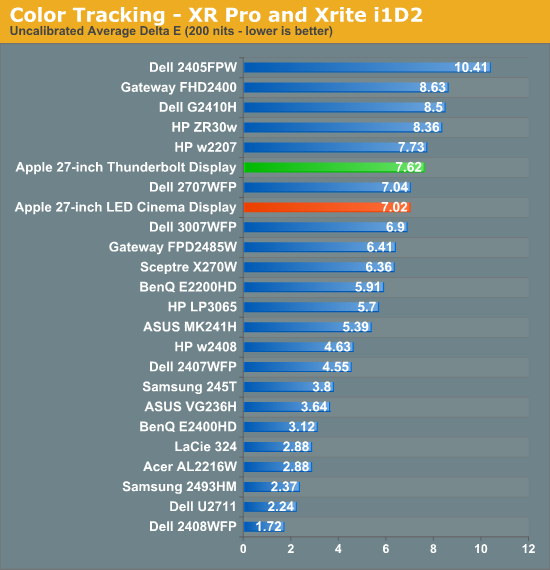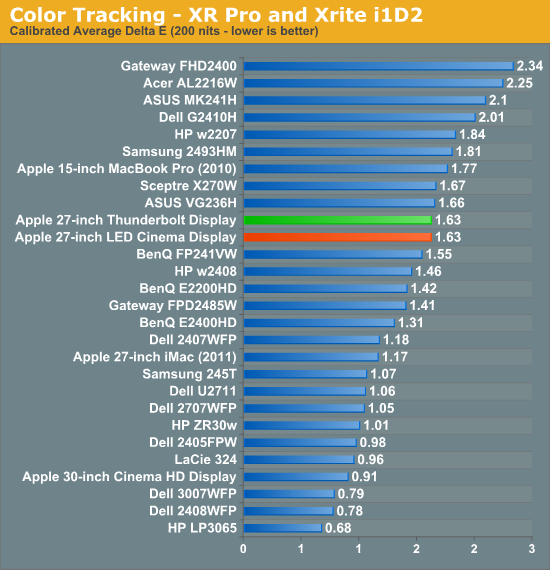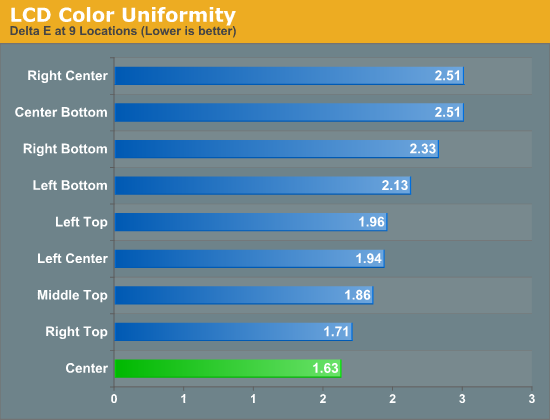The Apple Thunderbolt Display Review
by Anand Lal Shimpi on September 23, 2011 2:56 AM EST- Posted in
- Displays
- Mac
- Apple
- Thunderbolt
- Thunderbolt Display
Display Testing
With all of the extra connectivity there is to test with the Thunderbolt Display we can't forget the actual panel testing. Thankfully this part is pretty simple, the display characteristics are near identical to the 27-inch LED Cinema Display we reviewed last year.
Color Quality
We report two main quality metrics in our display reviews: color accuracy (Delta-E) and color gamut. Color gamut refers to the range of colors the display is able to represent with respect to some color space. In this case, our reference is the AdobeRGB 1998 color space, which is larger than the sRGB color space. So our percentages are reported with respect to this number, and larger is generally better.
Color accuracy (Delta E) refers to the display’s ability to display the correct color requested by the GPU and OS. The difference between the color represented by the display, and the color requested by the GPU is our Delta-E, and lower is better here. In practice, a Delta E under 1.0 is perfect - the chromatic sensitivity of the human eye is not great enough to distinguish a difference. Moving up, a Delta E of 2.0 or less is generally considered fit for use in a professional imaging environment - it isn’t perfect, but it’s hard to gauge the difference. Finally, Delta E of 4.0 and above is considered visible with the human eye. Of course, the big consideration here is frame of reference; unless you have another monitor or some print samples (color checker card) to compare your display with, you probably won’t notice. That is, until you print or view media on another monitor. Then the difference will no doubt be apparent.
As I mentioned in our earlier reviews, we’ve updated our display test bench. We’ve deprecated the Monaco Optix XR Pro colorimeter in favor of an Xrite i1D2 since there are no longer up-to-date drivers for modern platforms.
For these tests, we calibrate the display and try to obtain the best Delta-E we can get at 200 nits of brightness for normal use. We target 6500K and a gamma of 2.2, but sometimes the best performance lies at native temperature and another gamma, so we try to find what the absolute best performance could be. We also take an uncalibrated measurement to show performance out of the box using either the manufacturer supplied color profile, or a generic one with no LUT data. For all of these, dynamic contrast is disabled.

Uncalibrated performance remains fairly similar to last year's LED Cinema Display, however once calibrated the Thunderbolt Display is spot on with its predecessor:

As we mentioned earlier, a sub 2.0 delta E is good enough for professional use. Although not perfect the Thunderbolt Display falls within that range for sure.


We measured slightly lower color gamut on the Thunderbolt Display than the original LED Cinema Display, however the result was much closer to the 2011 27-inch iMac. I couldn't visibly tell any differences and Apple indicates that color gamut shouldn't have changed, so it's quite possible that the differences here are due to our colorimeter and not the panel.
Color Uniformity
Now for color consistency, we take our best calibration profile from the very center at 200 nits and test color accuracy at 9 different places around the LCD display in an evenly distributed grid. We’ve shown before that calibration is localized across the display, partly due to the brightness not being uniform, partly due to the discrete nature of the display itself.

The Thunderbolt Display was fairly uniform across its surface, something we noticed in reviewing the 27-inch LED Cinema Display last year. Uniformity is actually better on this panel than the one we reviewed last year, although in both cases I couldn't really tell any differences.
Peak brightness appears down slightly, but so are the black levels which result in a slightly better contrast ratio. Apple is also calibrating these things at the factory now so white points are now set at around 6300K vs. 7100K on the original 27-inch LED Cinema Display.










275 Comments
View All Comments
JasperJanssen - Saturday, September 24, 2011 - link
Not every product merits an in-depth review. 1 in-depth equals about 4 or 5 short reviews, and every site has to choose carefully how to spend its time.The first time we saw SF2000, there were *massive* reviews. If Samsung would suddenly put out an SSD that is a few dozen percent faster than the current fastest SSD, (and not cost the earth) it'll no doubt get an extensive review. When Apple puts out something very new that could well be the way of the future for the industry as a whole, they get a large review. Makese sense to me.
And before you jump all over me on that score: Just look at the Sony implementation of Light Ridge on the current Vaio Z. That's a docking station that has everything this thing has (apart from the display) and some more.
The market as a whole may well not go for integration into displays and integrated power supplies, but Thunderbolt/Thunderbolt-style docking stations seem likely to sweep the world.
Zink - Friday, September 23, 2011 - link
+1 top notch video review in every waySunrise089 - Friday, September 23, 2011 - link
Agree as well. While I definitely hope the text reviews will continue and receive the most resources, these video reviews are a great supplement, especially with less "numbers driven" products like displays and mobile devices.I wish all the CNET, television, etc. reviewers would take a look at this simple, engaging, intelligent review style and adopt it as well. Most reviewers spend way too much time trying to be entertaining and talking down to their audience.
Anand Lal Shimpi - Friday, September 23, 2011 - link
The text reviews will continue, this is simply something we're experimenting with to offer an augment :)It's always been my opinion that we should treat the readers as equals. It turns out that if you don't treat your readers like idiots then you'll find that you actually attract some really smart people :)
Take care,
Anand
Constructor - Friday, September 23, 2011 - link
The video was quite good indeed.And I like the eye-level-approach. Especially since you had a pretty good balance between talking about the actually interesting bits and still keeping it easy to follow.
Maybe in some places you might want to slow down just a tiny little bit. ;-)
Iketh - Friday, September 23, 2011 - link
NOO!! If anything Anand, talk even faster! Throw it at me at full GigE! I'm a busy man!Constructor - Friday, September 23, 2011 - link
Just play the video in fast forward then. ;-))pmcg - Friday, September 23, 2011 - link
I agree too. What an impressive setup and continuous, cogent presentation. I have never seen a video of Anand but now that I have, I demand more! Should there be an anandtech.tv?jleeworking - Saturday, September 24, 2011 - link
Wow! nicely done, can we have more of those videos?mymoon - Saturday, September 24, 2011 - link
Also agreed! Well done Anand on the video review. Felt my time well spent.